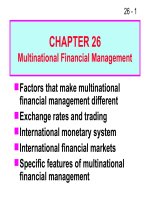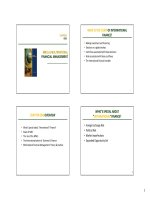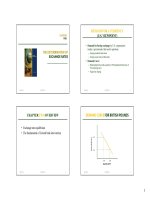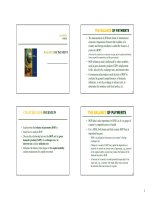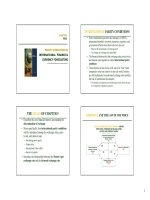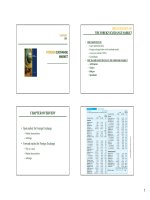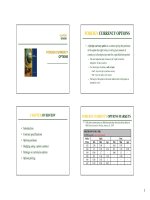Multinational financial management 7th CH11
Bạn đang xem bản rút gọn của tài liệu. Xem và tải ngay bản đầy đủ của tài liệu tại đây (839.32 KB, 36 trang )
Multinational Financial
Management
Alan Shapiro
7th Edition
J.Wiley & Sons
Power Points by
Joseph F. Greco, Ph.D.
California State University, Fullerton
1
CHAPTER 11
MEASURING AND
MANAGING
ECONOMIC
EXPOSURE
2
CHAPTER OVERVIEW
I.
FOREIGN EXCHANGE RISK AND
ECONOMIC EXPOSURE
II. THE ECONOMIC CONSEQUENCES
OF
EXCHANGE RATE CHANGES
III. IDENTIFYING ECONOMIC EXPOSURE
IV. CALCULATING ECONOMIC EXPOSURE
V. AN OPERATIONAL MEASURE OF
EXCHANGE RISK
VI. MANAGING OPERATING EXPOSURE
3
PART I.
FOREIGN EXCHANGE RISK AND ECONOMIC
EXPOSURE
I. FOREIGN EXCHANGE RISK
A. Economic exposure
focuses on the impact of currency
fluctuations on firm’s value.
1 . Expectations about the fluctuation
must be
incorporated in all basic
decisions of the firm.
4
FOREIGN EXCHANGE RISK AND
ECONOMIC EXPOSURE
2. Definitions:
a. Accounting exposure
impact on firm’s balance sheet
b.
Economic exposure
1.) Transaction
2.) Operating
5
FOREIGN EXCHANGE RISK AND
ECONOMIC EXPOSURE
THE REAL EXCHANGE RATE
et' et
(1 i f ) t
(1 ih ) t
6
FOREIGN EXCHANGE RISK AND
ECONOMIC EXPOSURE
B. Real Exchange Rates and Risk
1. Nominal v. real exchange
rates:
the real rate has been
adjusted
for price changes.
7
FOREIGN EXCHANGE RISK AND
ECONOMIC EXPOSURE
3. SUMMARY
a. the economic impact of a
currency change depends on the offset
by the difference in inflation
rates
or the real exchange rate.
b. It is the relative price changes
that ultimately determine a firm’s
long-run exposure.
8
PART II. THE ECONOMIC CONSEQUENCES
OF EXCHANGE
RATE CHANGES
II.
ECONOMIC CONSEQUENCES
A. Transaction exposure
1. On-balance sheet
2. Off-balance sheet
9
THE ECONOMIC CONSEQUENCES
OF EXCHANGE RATE CHANGES
II. ECONOMIC CONSEQUENCES
(con’t)
B. Operating Exposure : real rate
change
1. Pricing flexibility is key
2. Product differentiation
3. Substitution of inputs
10
THE ECONOMIC CONSEQUENCES
OF EXCHANGE RATE CHANGES
II.SUMMARY
The sector of the economy in which the
firm operates;
the sources of the firm’s inputs;
and
fluctuations in the real exchange rate
delineate the firm’s true economic
exposure.
11
PART III. IDENTIFYING
ECONOMIC EXPOSURE
III.
CASE STUDIES OF ECONOMIC
EXPOSURE
A. ASPEN SKIING COMPANY
1. Firm’s exchange rate risk
affected its sales revenues.
12
IDENTIFYING ECONOMIC
EXPOSURE
A.
ASPEN SKIING COMPANY (con’t)
2. Although there was no translation
risk, the global market with its
exchange rate risk and its
competitors impacted market
demand.
13
IDENTIFYING ECONOMIC
EXPOSURE
B. PETROLEOS MEXICANOS (PEMEX)
1. The firm’s exchange rate risk
affected cost but not revenues.
2. Economic impact
a. Revenues: none
b. Costs:
decreased
c. Net effect:
increased US$ flows
14
IDENTIFYING ECONOMIC
EXPOSURE
C. TOYOTA MOTOR COMPANY
1.
Exchange rate risk affected BOTH
revenues and costs.
2.
Flow back effect:
previously exported goods return
with increased domestic
competition.
3.
Lower profit margins domestically
15
PART IV. CALCULATING
ECONOMIC EXPOSURE
IV. A quantitative assessment of
economic
exposure depends on underlying
assumptions concerning:
A. future cash flows;
B. sensitivity to exchange rate
changes.
16
PART V. AN OPERATIONAL
MEASURE OF EXCHANGE RISK
V.
NEED FOR A WORKABLE APPROACH
A. Regression Analysis
1.
Variables
a.
Independent:
changes in parent’s cash
flows
b.
Dependent:
Average nominal exchange rate
17
change.
AN OPERATIONAL MEASURE OF
EXCHANGE RISK
B. REGRESSION EQUATION
-approach based on the operational
definition of the exchange risk faced by a
parent or one of its affiliates:
-a company faces exchange risk to the
extent that variations in the dollar value
of the unit’s cash flows are correlated
with variations in the nominal exchange
rate
18
AN OPERATIONAL MEASURE OF
EXCHANGE RISK
CFt a EXCH t ut
where CFt =
CFt - CFt-1 and
CFt is the dollar
value of total affiliate(parent)cash
flows in period t
EXCHt =
EXCHt - EXCHt-1 equals the
average
nominal exchange rate during period t
u = a random error term
19
AN OPERATIONAL MEASURE OF
EXCHANGE RISK
1. Output measures:
a. Beta coefficient (
measures the association
of
changes in cash flows
to
exchange rate
changes.
20
AN OPERATIONAL MEASURE OF
EXCHANGE RISK
b.
the higher the percentage
change of cash flow to
changes in exchange rates,
the greater the economic
exposure (higher beta
values).
21
AN OPERATIONAL MEASURE OF
EXCHANGE RISK
VI. SUMMARY:
A. The focus of the accounting
profession on the balance sheet
impact of currency changes has led
to ignoring the important
impact
on future cash flows.
22
AN OPERATIONAL MEASURE OF
EXCHANGE RISK
B.
For firms incurring costs and selling
products in foreign countries,
the net
effect of currency
changes may be less
important in
the long run.
23
AN OPERATIONAL MEASURE OF
EXCHANGE RISK
C.
To measure exposure properly, you
must focus on inflation-adjusted or
real
exchange rates instead of
nominal or
actual exchange
rates.
24
AN OPERATIONAL MEASURE OF
EXCHANGE RISK
D. It is difficult in practice to
determine
what the actual
economic impact of a
currency
change will be.
25
